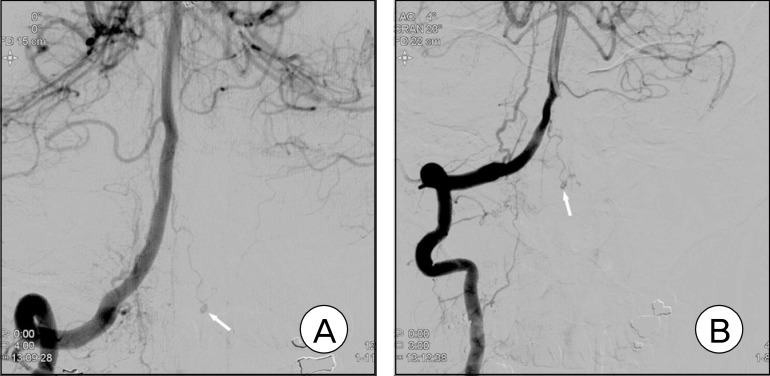1. Bahar S, Coban O, Gurvit IH, Akman-Demir G, Gokyigit A. Spontaneous dissection of the extracranial vertebral artery with spinal subarachnoid haemorrhage in a patient with Behcet's disease. Neuroradiology. 1993; 35(5):352–354. PMID:
8327110.
2. Berlis A, Scheufler KM, Schmahl C, Rauer S, Gotz F, Schumacher M. Solitary spinal artery aneurysms as a rare source of spinal subarachnoid hemorrhage: potential etiology and treatment strategy. AJNR Am J Neuroradiol. 2005; 2. 26(2):405–410. PMID:
15709145.
3. Biondi A, Merland JJ, Hodes JE, Pruvo JP, Reizine D. Aneurysms of spinal arteries associated with intramedullary arteriovenous malformations. I. Angiographic and clinical aspects. AJNR Am J Neuroradiol. 1992; May-Jun. 13(3):913–922. PMID:
1590191.
4. Caglar YS, Torun F, Pait G, Bagdatoglu C, Sancak T. Ruptured aneurysm of the posterior spinal artery of the conus medullaris. J Clin Neurosci. 2005; 6. 12(5):603–605. PMID:
15975794.

5. Henson RA, Croft PB. Spontaneous spinal subarachnoid haemorrhage. Q J Med. 1956; 1. 25(97):53–66. PMID:
13323242.
6. Hino H, Maruyama H, Inomata H. [A case of spinal artery aneurysm presenting transverse myelopathy associated with coarctation of the aorta]. Rinsho Shinkeigaku. 1989; 8. 29(8):1009–1012. Japanese. PMID:
2689031.
7. Jiarakongmun P, Chewit P, Pongpech S. Ruptured anterior spinal artery aneurysm associated with coarctation of aorta. Case report and literature review. Interv Neuroradiol. 2002; 9. 8(3):285–292. PMID:
20594486.
8. Karakama J, Nakagawa K, Maehara T, Ohno K. Subarachnoid hemorrhage caused by a ruptured anterior spinal artery aneurysm. Neurol Med Chir (Tokyo). 2010; 50(11):1015–1019. PMID:
21123989.
9. Kawamura S, Yoshida T, Nonoyama Y, Yamada M, Suzuki A, Yasui N. Ruptured anterior spinal artery aneurysm: a case report. Surg Neurol. 1999; 6. 51(6):608–612. PMID:
10369227.

10. Klingler JH, Glasker S, Shah MJ, Van Velthoven V. Rupture of a spinal artery aneurysm attributable to exacerbated Sjogren syndrome: case report. Neurosurgery. 2009; 5. 64(5):E1010–E1011. discussion E1011. PMID:
19404125.
11. Kocak A, Ates O, Cayli SR, Sarac K. Isolated posterior spinal artery aneurysm. Br J Neurosurg. 2006; 20(4):241–244. PMID:
16954077.
12. Lavoie P, Raymond J, Roy D, Guilbert F, Weill A. Selective treatment of an anterior spinal artery aneurysm with endosaccular coil therapy. Case report. J Neurosurg Spine. 2007; 5. 6(5):460–464. PMID:
17542515.
13. Longatti P, Sgubin D, Di Paola F. Bleeding spinal artery aneurysms. J Neurosurg Spine. 2008; 6. 8(6):574–578. PMID:
18518680.

14. Moore DW, Hunt WE, Zimmerman JE. Ruptured anterior spinal artery aneurysm: repair via a posterior approach. Neurosurgery. 1982; 5. 10(5):626–630. PMID:
7099415.
15. Pollock JM, Powers AK, Stevens EA, Sanghvi AN, Wilson JA, Morris PP. Ruptured anterior spinal artery aneurysm: a case report. J Neuroimaging. 2009; 7. 19(3):277–279. PMID:
18681926.

16. Sharma S, Kumar S. Hematomyelia due to anterior spinal artery aneurysm in a patient with coarctation of aorta. Neurol India. 2010; Jul-Aug. 58(4):675–676. PMID:
20739828.

17. Thomson RL. Aneurysm in the cervical spinal canal. Med J Aust. 1980; 3. 1(5):220–222. PMID:
7374566.

18. Vincent FM. Anterior spinal artery aneurysm presenting as a subarachnoid hemorrhage. Stroke. 1981; Mar-Apr. 12(2):230–232. PMID:
7233470.

19. Walz DM, Woldenberg RF, Setton A. Pseudoaneurysm of the anterior spinal artery in a patient with Moyamoya: an unusual cause of subarachnoid hemorrhage. AJNR Am J Neuroradiol. 2006; 8. 27(7):1576–1578. PMID:
16908584.
20. Yonas H, Patre S, White RJ. Anterior spinal artery aneurysm. Case report. J Neurosurg. 1980; 10. 53(4):570–573. PMID:
7420184.
21. Yoong MF, Blumbergs PC, North JB. Primary (granulomatous) angiitis of the central nervous system with multiple aneurysms of spinal arteries. Case report. J Neurosurg. 1993; 10. 79(4):603–607. PMID:
8410233.








 PDF
PDF ePub
ePub Citation
Citation Print
Print


 XML Download
XML Download